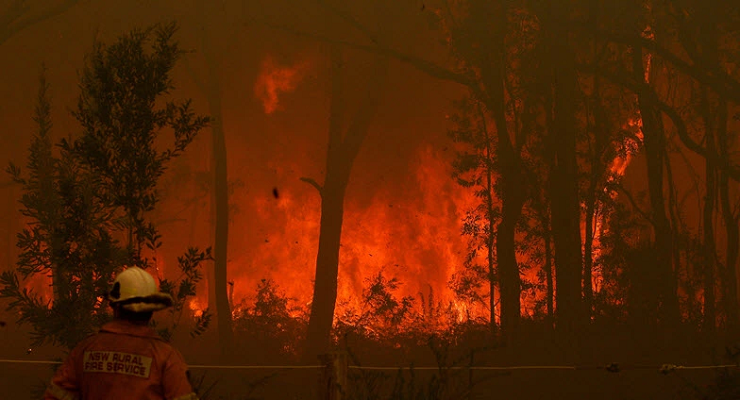
After three years of wet weather, Australia’s eastern states are back in the red.
Yesterday Sydney sweated through its hottest day in more than two years, with maximums of 40.6C at the airport and 40.1C in the west. Temperatures around the state also teetered on 40 with nearly as many wildfires. There are still 12 blazes yet to be contained. Further north, southern Queensland is reeling from a series of out-of-control blazes that authorities anticipate will flare up again this week.
Victor Steffensen, lead fire practitioner of Indigenous-led network Firesticks, is not at all surprised.
“We’re seeing lands being wiped out over and over again because Western agencies keep making the same mistakes,” he told Crikey. “I warned them a few months ago that was going to happen.”
In the years since the deadly 2019-20 bushfire season, Steffensen said the national approach to bushfire mitigation has barely budged despite recommendations from the Royal Commission into National Natural Disaster Arrangements that government at all levels (local, state, territory, and federal) “explore” and engage in Indigenous land and fire management.
“Once again, it’s the Western science leading on something they know very little about,” he said. “We live in their system where the most experienced person gets the job. And yet you’ve got uneducated people in charge of the landscape. It really is back to front.”
Compare the pair
Government and fire services across the country continue to rely heavily on hazard reduction burns for bushfire prevention. The aim? Reduce fuel loads so that when (not if) a wildfire comes, there’s less to burn. It’s a one-size-fits-all system — no plant and no soil type receive special treatment. Landscapes are simply burnt on a hectare basis.
For Indigenous burning, respecting the identity of an ecosystem is fundamental to fire management. Steffensen explained that because every piece of land is unique, so too is the application of fire.
The aim of cultural burning — unlike hazard reduction burning — is to encourage growth of plants that are natural and native to a particular ecosystem. That means eradicating invasive species (weeds) and invasive natives (native plants in the wrong place that therefore function as weeds) from ecosystems. Healthy country that wears its ID loud and proud is considerably less flammable than landscapes covered in weeds, often spurred by hazard reduction burns.
“The problem today is that the majority of Australians don’t know what country is supposed to look like. They look at the landscape and say, ‘Oh, I see trees, what a healthy landscape,’ but they’re the wrong trees. And if you looked at the forest floor, there’s no grasses, it’s all weeds,” Steffensen said.
This is not your home
Last week an ecologist at James Cook University called for an overhaul of invasive species, arguing that the weeds had adapted to native Australian landscapes and therefore should be rebadged as “new natives”.
Steffensen said such rhetoric was “very, very dangerous” by accepting the “sick condition” of landscapes as a permanent state of being, while also undermining the efforts and agency of Indigenous people looking after the land.
“Statements like that need to be knocked in the head. Those plants come into ecosystems, they take water differently, they change our soils, they compete against our native plants, they create monocultures. And they are a real high fire risk,” he said, adding that they are not and will never be an indicator of healthy land.
So long as Australia continues to to overlook Indigenous knowledge and science, Steffensen said the nation will be stuck on repeat — wildfire after wildfire.
“Unfortunately, we do have land in areas where I think, ‘Man, we’re never gonna be able to fix this because they’ve just totally destroyed it.’ But the positive side of it is that we are healing,” he said.
“Although we’re doing it by paddling upstream with no paddle.”
Should Indigenous fire controls become the norm in Australia? Let us know by writing to letters@crikey.com.au. Please include your full name to be considered for publication. We reserve the right to edit for length and clarity.








Does our James Cook ecologist also think that we should class rabbits, cats, cane toads, starlings and carp as ‘new native’ species? That is a brain fart of such magnitude that I can only hope that someone lit a match while it emerged.
That’s all fair enough. But we should not disregard the good work done by scientists such as David Lindenmayer and Philip Zylstra who also know a great deal about fire ecology, particularly in light of the changed conditions caused by climate change.
Perhaps we have an Australian of the Year in the wings? Give the man a fair hearing, plenty of resources and a trial over maybe five years. If his land control works better than what clearly isn’t now, mandate it!
An expert on orchids in the south of WA told a group of us that the controlled burn frequency in his locality would ensure the extinction of various such species (due to seeding patterns and longevity) – he had asked the local fire brigade to increase the frequency by a couple of years but they were not interested.
Ignorance is bliss.
The more they burn, the more they have to burn.